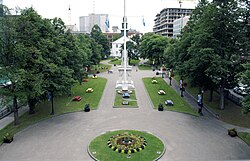Grand Parade (Halifax)
| Grand Parade | |
|---|---|
| Public square | |

Grand Parade viewed from City Hall
|
|
| Features: | Cenotaph, flagpole |
| Opening date: | 1749 |
| Area: | 0.6 hectares (1.5 acres) (approx) |
| Surface: | Grass, brick |
| Location: | Halifax, Nova Scotia |
The Grand Parade (sometimes incorrectly referred to as "Parade Square") is an historic military parade square dating from the founding of Halifax in 1749. At the north end of the Grand Parade is the Halifax City Hall, the seat of municipal government in Nova Scotia's Halifax Regional Municipality. At the south end is St. Paul's Church. In the middle of Grand Parade is the cenotaph built originally to commemorate the soldiers who served in World War I.
Centrally located in Downtown Halifax, the square remains an important civic space used for numerous events including musical performances, political demonstrations, the annual New Year's Eve celebrations, Remembrance Day ceremonies, and Christmas tree lighting.
The first contingent of British settlers in Halifax arrived in June 1749 and completed 300 houses by October 1749. Lieutenant John Brewse, a military engineer, sited the town within a defensive perimeter while Charles Morris, appointed Chief Surveyor on 25 September 1749, worked on the town layout and probably conducted the actual surveying. Moses Harris, a settler skilled in draughting, published the town plan for Halifax in 1749. It comprised an urban grid made up of oblong, rectangular city blocks with the Grand Parade at the centre of the town. The plan stipulated a church at one end of the square (opened 1750), and a courthouse and prison at the northern end. However, the north end remained vacant.
Shortly after arriving in Halifax, Governor Cornwallis ordered framing from Boston for the construction of a church. The cornerstone for the church was laid on 13 June 1750. It was named St. Paul's in 1759 when a parish of that name was established. The building was modeled off Marybone Chapel in London.
In 1794 Prince Edward arrived in Halifax to command the military in Nova Scotia and New Brunswick. He set about improving the military facilities around the city, and had the Grand Parade leveled to improve its usefulness. As Barrington Street slopes down toward the north of Grand Parade, a retaining wall was built here to keep the square level. The retaining wall is tall enough to accommodate inhabitable space underneath the square, with frontage on Barrington. This space originally accommodated ice houses for Mrs. Jane Donaldson, a Granville Street merchant.
...
Wikipedia
